Your guide to Lakagígar, Iceland
Visit Skaftafell and one of the natural wonders you’ll come across are the well-known Lakagígar craters. Also called the Laki craters, they’re part of a volcanic system in the Icelandic highlands.
The craters and volcanic fissures formed in the summer of 1783 during one of the most damaging eruptions since records began. You’ll find them stretched out in a 25 km (15.5 mi) line that cuts through Laki mountain.
The 8-month-long event began in June 1783 and ended in February 1784. During that time, lava flowed from the fissures and toxic ash and gases were released into the atmosphere.
Most of the livestock in Iceland died as a result, which led to a famine that killed around a fifth of the Icelandic population. The locals called this deadly fallout Móðuharðindin or the ‘Mist Hardships’.
Learn more about the Laki eruption
If you dig into the effects of the eruption, it becomes clear that it had consequences far beyond Iceland.
Take a guided tour of the area in a super jeep and you’ll probably hear that the series of blasts produced an enormous ash cloud. The vast amounts of gases and ash released into the air even caused a shift in the Northern Hemisphere’s climate.
This meant that weather systems were disrupted across Europe, North America, and even as far away as North Africa. In some areas, these changes caused devastating crop failures.
In fact, the food shortages and economic instability that followed in northern Europe even contributed to the French revolution in 1789.





